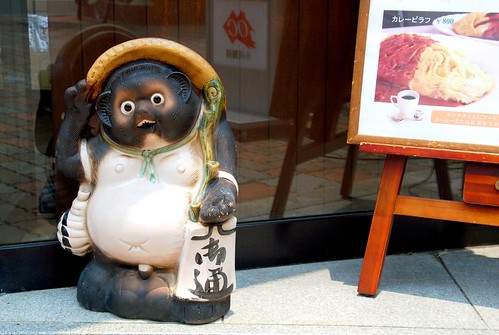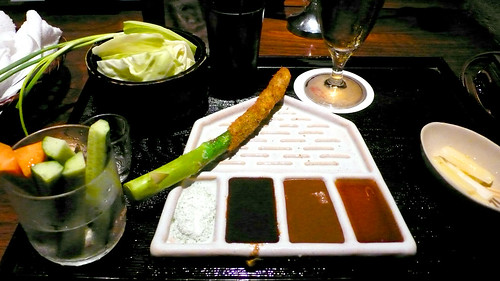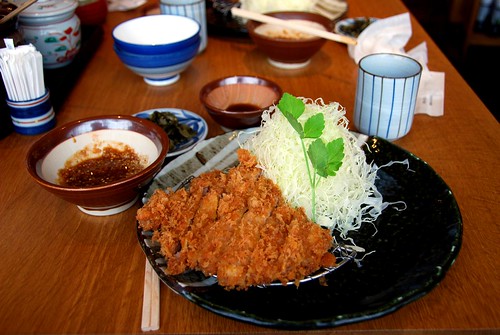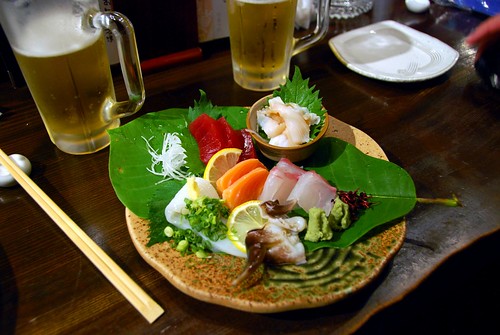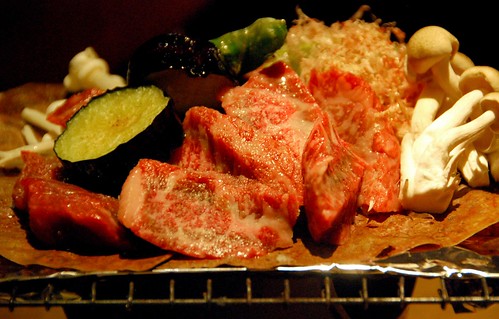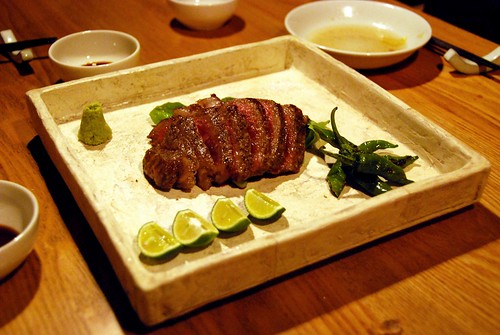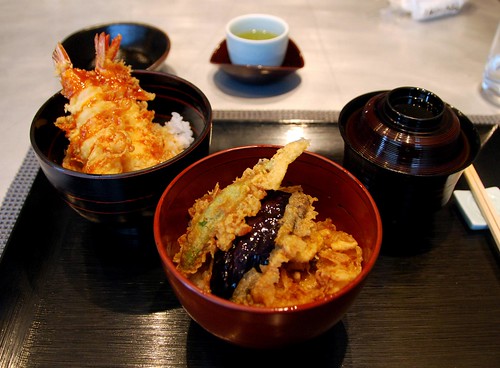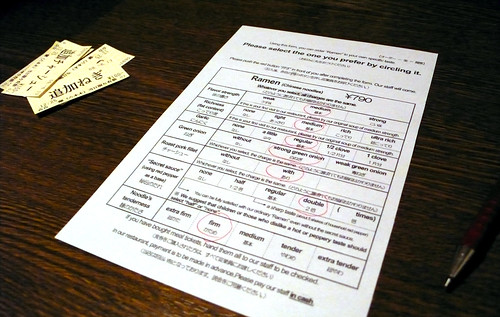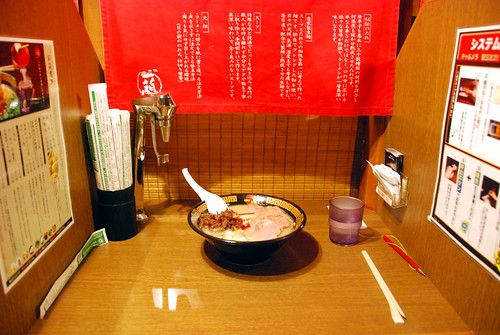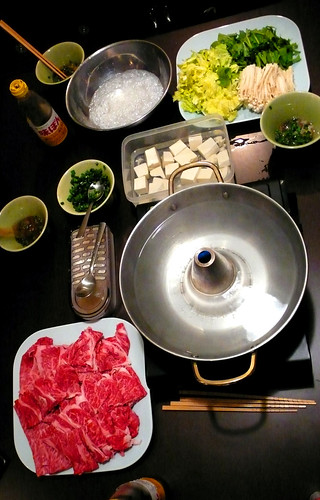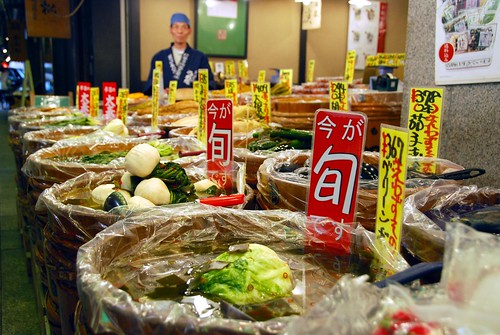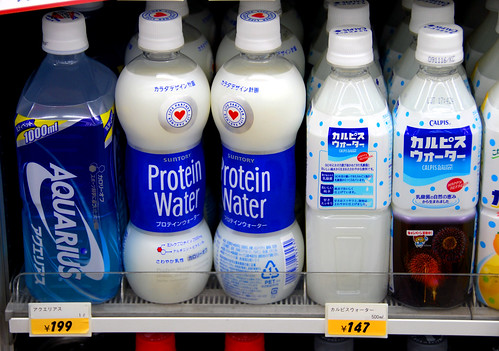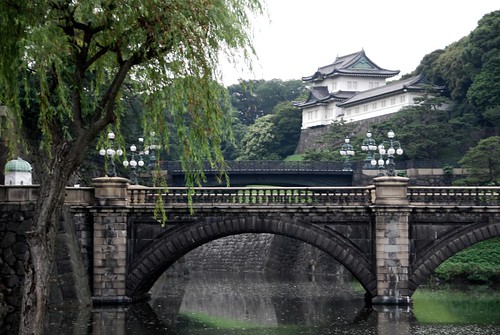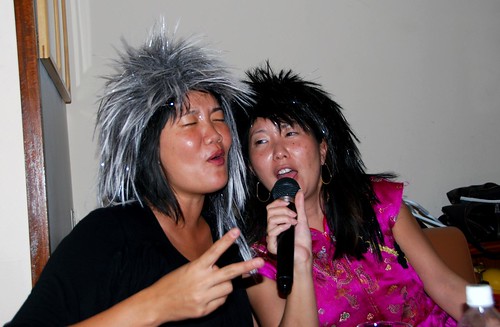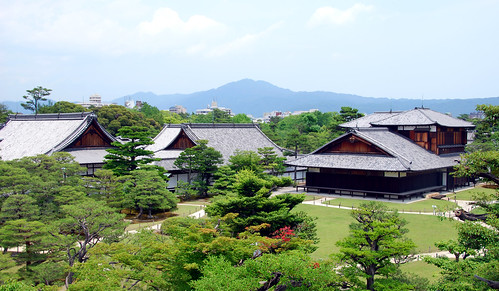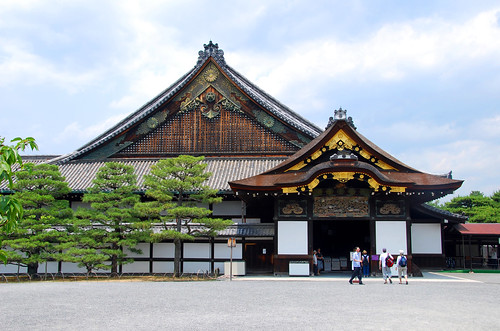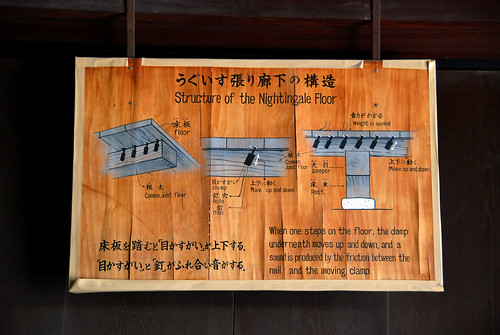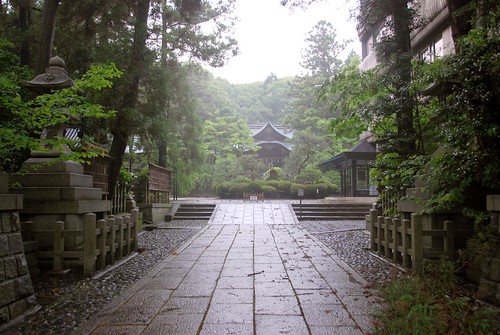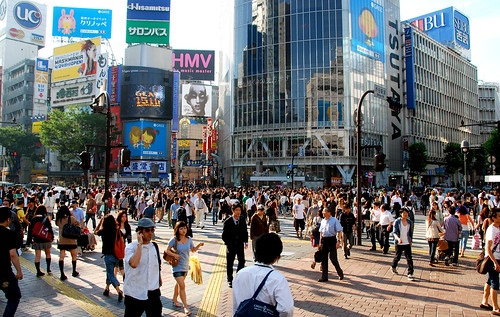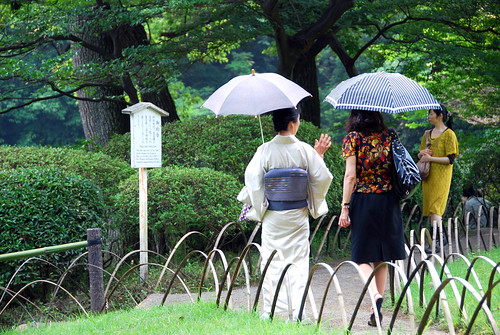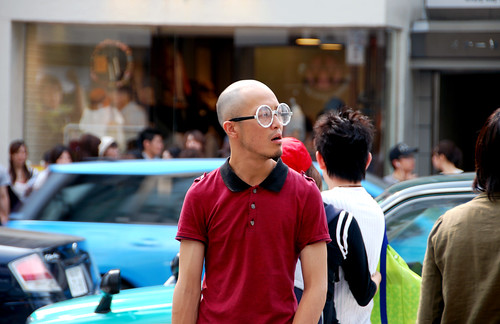Search results for "tokyo"
If you like your culture with a dash of comfort, or your peace with a little quiet, then Japan is the name of your travel game. Japan felt like an oasis in the middle of crazy, chaotic Asia, and we found a lot of similarities between the culture here and the one we fell in love with in Taiwan.
Over here at 12FOOT3, Jeremy is the nature lover and I’m the culture vulture, and Japan has got enough to keep us both happy. From fashion, art, style, and design in Tokyo to forests, flowers, and bamboo in Koyasan, (or the intersection of nature and culture in Naoshima), Japan has got it all. Go, and let us know what you think. We’re pretty sure you’ll love it too.
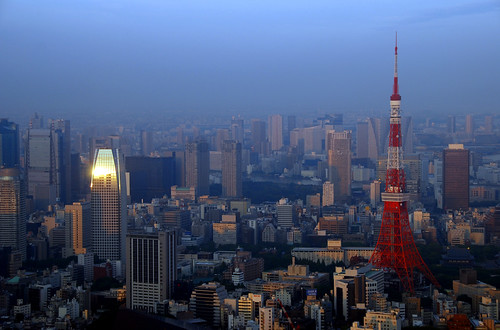
View of Tokyo Tower from the Mori building.
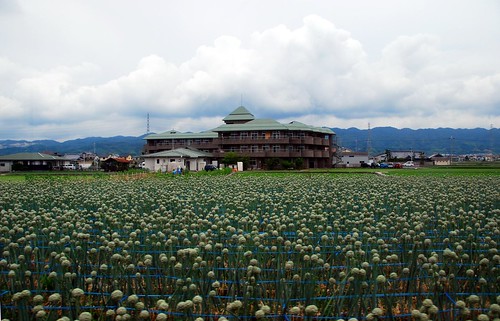
The Japanese countryside, somewhere between Osaka and Naoshima.
Days spent here: 19
Highlights: There wasn’t a place we didn’t like: Tokyo, Kyoto, Koyasan, Naoshima, Takayama—each big city or little town was fabulous in its* own way. Shirahama was a bit resort-y for our tastes, but since we were there before the start of the “official” beach season, it was empty and quiet. That, and the fabulous onsen on the beach, made it worth the trip.
* Hi Adam!
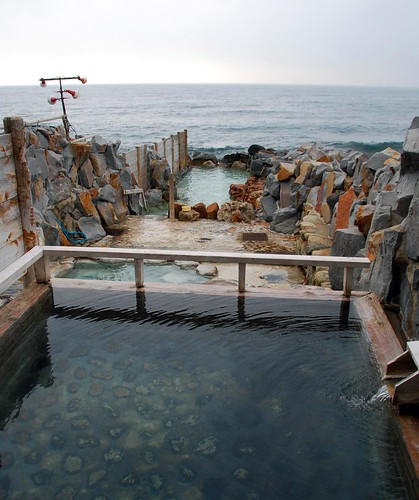
Sakino-yu onsen in Shirahama. The Pacific Ocean crashes over the wall into the cold pool.
Places we would like to visit next time: For us, it’s less about where we’ll go next time and more about when we’ll go. We’ll gladly return to Japan in spring (cherry blossom season), autumn (fall colors painting the Japanese maples), or winter (snow sitting on temple rooftops).
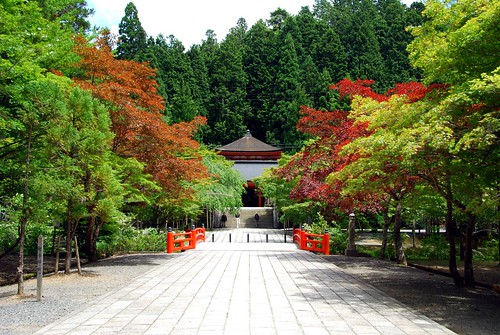
A taste of what autumn in Japan might look like. Taken in Okunoin cemetery, Koyasan.
Average daily expenditures: US$240 (Ouch! Though a good US$50 a day was due to our JR Rail passes.)
Prices: Yup, Japan is expensive. Food is expensive, accommodation is expensive (see the accommodation section below to find out why), and public transport is…guess what? Expensive. In return for parting with your hard-earned cash, you get fabulous food, a high level of comfort and cleanliness in the guest houses, and some of the fastest, easiest, and most convenient transport experiences you can find in this world. In other words, you get what you pay for in Japan. But be prepared to pay a lot.
Weather: We were traveling in Japan during the supposed “rainy season” (June), though it only rained hard twice (and then boy did it rain!). Most days were overcast, humid, but not too hot (maybe mid-70s to 80s?).
Language: Hey you out there! Yeah, you…the one who thinks all Asians look alike and wouldn’t be able to tell a Beijing babe from a Tokyo Tomo. Well, guess what? You’re off the hook for cultural insensitivity, because apparently Asians think all Asians look alike too. EVERYONE in Japan thought I was Japanese and would rattle on to me for several minutes before they caught on to my blank stare. I would have the following conversation with at least one Japanese person every day:
Japanese Person: Irashaimase! Tekka tekka tekka tekka tekka HAI! Tekka HAI! Tekka tekka tekka HAI!
Hope: Uh, watashi wa…
JP: [waiting patiently]
H: …nihongo ga…
JP: [still waiting patiently]
H: …wakari masen*. (Translation: “Um…I don’t understand Japanese”)
JP: Oooaawwaahh**! HAI!
* I had to learn this phrase immediately upon leaving Tokyo.
** Japanese people make the most amazing sound effects.
Food: Yo, it’s good.
One thing I forgot to mention in my food post—some of you are probably wondering what the deal is with the $40 melon or the $60 grapes you hear so much about. It’s not like Japanese people have to take out a second mortgage in order to eat fruit. Rather, these are gift items—a $40 melon is a token that shows your appreciation for the receiver of said fruit. See, everyone knows that THAT is the $40 melon, and the receiver will know it too.
Accommodation: A big chunk of your travel budget in Japan will go towards accommodation. Why? Well, in Japan, rather than paying for a room, you pay by the person. So if you are a single person traveling, you might get a room to yourself for ¥4000 (about US$40). But a couple staying in a similar room will have to pay ¥8000. That’s just the way they do things in Japan. Them’s the breaks.
Budget places tend to run between ¥3000 to ¥4000 (US$30-40) per person per night. So even a budget hotel will cost a couple US$80 per night. For that reason, Tokyo and Kyoto are a good place to try to use miles on hotels if your mileage program will let you do so, because housing is extra expensive in the big cities. You can also try JAPANiCAN, which often has great deals on accommodation.
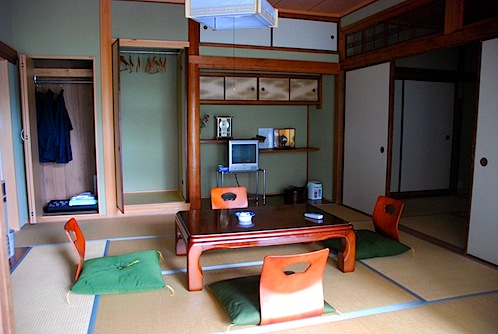
A typical Japanese-style room (though this one is quite spacious).
If you’re traveling on a budget, you’ll want to look for shukubo (temple lodgings), kokumin shukusha (”people’s lodges”), and minshuku (the Japanese version of bed and breakfast, downmarket from the fabulous ryokan). Sometimes a minshuku will offer you a choice of Western or Japanese-style room. We always opted for the Japanese-style accommodation, which means your room will have tatami mats, a small coffee table surrounded by cushions or chairs (like the one pictured above), your bed will be a futon mattress stored in the closet and brought out at night, and your pillow will be stuffed with buckwheat.
Again, despite the high costs, you will get quality from Japanese hotels and guest houses—your room will come with a cute kimono-style robe, a tea set and hot water heater, and (if you stay in the Super Hotel in Kyoto) your choice of pillows (buckwheat, memory foam, or feather, of different densities and thicknesses). Plus a little Japanese atmosphere to boot if you choose the local style accommodation.
Transit: Japan’s national rail system is really, really amazing. You can get to every corner of the country…and often at no additional cost if you spring for the JR Rail Pass. Granted, the pass is not cheap, but you definitely get what you pay for. The trains are super fast, efficient, ultra clean, and comfortable.
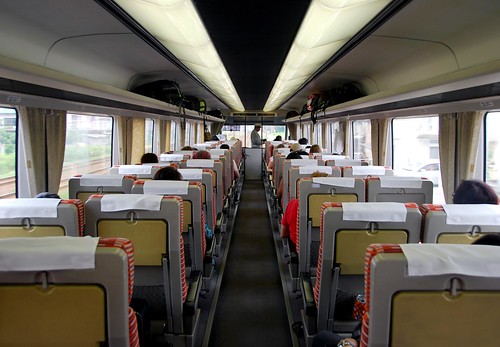
On the train from Takayama to Tokyo.
I know that Tokyo’s Metro is supposedly a transit lover’s dream come true, but we found it hard to navigate at times (seriously, the maps look like a pile of multi-colored noodles!).
Internet: As we’ve come to find on our travels so far, Japan adheres to the unwritten international commandment of “developed countries shall be stingy with their wifi.” If our guest house did not have wifi, we could sometimes find an unlocked connection on the street. Of course, my iPod Touch chose to break down in this country, which made it even harder to keep up with friends and family back home. I ended up buying a new iTouch in Tokyo (interestingly, one of the cheapest places in the world to get one…but only by a little bit).
Culture: What you’ve heard about Japan is true—people are exceedingly polite. But Japan is also a rules-based society, and as our hosts Joy and Alex explained, you can ask a person for directions and they are so polite that they walk you to your destination—but ask them to do anything (ANYTHING!) that is against the rules or the process, and you’re in for a long struggle. Put the mustard on the side? Substitute lettuce for tomato? I don’t think so, Mr. Big Shot Rule-Breaker Man! The problem is, again, Japanese people are so polite that they won’t just come right out and say “no.” Instead, they’ll talk around it…you’ll get answers like: “that might be difficult” or “um, I will need to ask if that is possible.” This cultural trait generally does not affect visitors much, but I imagine if you are a Westerner working in Japan (as Joy and Alex are), this can be really frustrating.
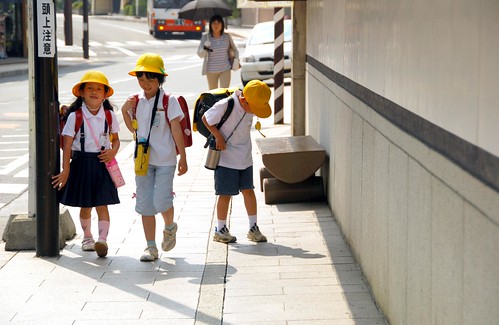
Schoolkids in Koyasan. Don’t they already look like good citizens? ![]()
The other insight our ex-pat friends shared with us: you don’t want to be around when a repressed Japanese person finally goes postal. Japan is exceedingly safe, but Joy admitted that the one time she ever feels scared in Japan is when someone is losing it. We saw a guy in Tokyo try to run another guy over at least 3 times (they were having some sort of argument).
The following video is really only tangentially related to the above topic, but it’s pretty funny so I thought I’d share:
The point of this “game” is to pop the other kids’ balloons mounted on their side of their helmet. WITH A STICK. About 12 seconds into the video, you can see one kid fall down and then all all the other kids start wailing on him/her.
The other well-documented aspect of Japanese culture is their obsession with the absurd. You’ve probably seen many examples of this, from Japanese game shows to useless inventions, etc. But the cutest example of Japanese weirdness has to be the raccoon dog. These little statues are everywhere, and they are called tanuki, a mythical creature that is jolly and mischievous. Our campsite in Naoshima even had a sign telling the raccoon dogs not to eat shoes or steal food (wish I took a picture of that)
Tanuki are characterized by their big pot bellies and get this—their humorously large testicles. I am not joking—there is even a schoolyard song about them:
Tan Tan Tanuki no kintama wa,
Kaze mo nai no ni,
Bura bura
Roughly translated, this means “Tan-tan-tanuki’s testicles, there isn’t even any wind but still go swing-swing-swing.”
I got all this from the Wiki entry so it MUST be true.
In short: It’s really, really lovely in Japan.
Let’s get one thing straight right off the bat: Japanese food is amazing. For any foodie whose palette prefers the fresh over the rich and the pleasure of a perfectly ripe vegetable over the heaviness of a cream sauce, Japan is your culinary heaven. (Though they do have some pretty rich dishes too…ramen, I’m looking at you…). Sure, Jeremy and I love Japanese food in the States too, but before coming to the Land of the Rising Sun, we didn’t realize just how bad the Japanese food in San Francisco was. Seriously, compared to the real thing on the other side of the Pacific, San Francisco’s Japanese food is just…sad. And limited too! Who knew there was more to Japanese food than sushi and some salty noodles in broth? Well, we do, now.
Kushi Katsu
This is possibly our favorite type of meal (after sushi) in Japan. Quite simply, it’s fried stuff on sticks. More eloquently, kushi katsu consists of vegetables, fish, and meat, rolled in panko breadcrumbs and fried to a golden perfection for not a minute too long or a second too short. On sticks.
The eating of said stuff-on-sticks is no county-fair dine-and-dash. No, no…kushi katsu dining is quite an experience. A typical menu might look something like this:
Pumpkin: ¥400
Eggplant: ¥800
Squid: ¥1400
Sea Eel: ¥2000
Asparagus: ¥2400
Green onion wrapped in pancetta: ¥3200
etc.
Now, this doesn’t mean that a green onion wrapped in pancetta is US$32, despite what you’ve heard about prices in Japan. Rather, this is a set menu: you start with pumpkin and wherever you stop eating, that’s what you pay for dinner (i.e., if you eat all the items listed above, you pay ¥3200). Along the way, you dip the stuff-on-sticks into a number of different sauces and spices, including parsley salt, mustard, shoyu, some sort of paprika/cayenne mix, and Worcestershire (the Japanese LOVE Worcestershire sauce!). Salad, pickles, and sliced veggies get the same dip treatment and are a refreshing source of roughage for the meal. But the star of the show is the veggies’ fried companions—Jeremy and I just can’t get over how perfectly everything is cooked. We all know how easy it is to overcook something when you’re frying it, but in kushi katsu, the veggies stay crisp and fresh inside their breadcrumb casing, and meat/fish is perfectly tender and done. And, IT’S ON STICKS.
Tonkatsu
This is a pork cutlet rolled in panko breadcrumbs, and then (like kushi kastu), fried to absolute perfection. It comes with a side of finely shredded cabbage, rice, and pickles. Along with the usual shoyu and Worcestershire sauce, you also get a small mortar filled with sesame seeds, which you grind with a pestle and then dump into a sauce mixture. Said sauce mixture is them used to either flavor your deep fried pork, or to dress that finely shredded cabbage.
Sushi and sashimi
This might be the most obvious statement ever made by (wo)mankind, but sushi is really good in Japan. We just didn’t realize how good it as going to be. Saying that the fish is like buttah is actually an insult to the fish. It’s better than butter…it’s more like eating the most perfectly clean, perfectly firm, perfectly tender, creamy, delicious piece of the ocean. And here’s the best-kept secret in Tokyo: sushi for lunch is the best deal you can get. For a few bucks more than a bowl of ramen, (about ¥1100, or US$11), you can get a gorgeous 12-piece sushi set lunch. Your taste buds and you wallet will be equally psyched.
Japanese Wagyu Beef
I think all we need to say about wagyu is that it’s marbled, fatty goodness. We sort of fell in love with Hida beef in Takayama…the photo above shows a special dish from the region wherein some chunks of fatty Hida beef get grilled on top of a magnolia leaf spread with miso paste.
We also had some delicious Kobe in Tokyo, with fresh lime squeezed on top and dipped in salt.
Tempura
Here’s the biggest shock of them all: tempura is serious culinary business in Japan. No, really: it’s considered an art form, and it’s expensive. Any self-respecting tempura chef would want to commit some hari-kari if he saw the limp and batter-sunken veggies that we get in the States. Also, you don’t just get the same old dipping sauce for every piece of tempura. Some items (like the squid I ordered), come with chili powder, salt, and lime. Others come with a curry powder as your dip. It’s all matched to the item in a way that complements the fried interior.
In conclusion: blah blah blah perfectly fried. Blah blah blah crisp veggies blah. Blah tender meat and fish blah blah. Bob Loblaw. You get it, right?
Ramen
Once we left Tokyo (and had to pay for housing), ramen became the meal we ate at least once a day, because it’s cheap and filling. And yet, we never tired of that rich, fatty, salt-bomb. Some ramen shops let you “customize” your bowl of noodles…choosing the doneness of the noodles, the fattiness of the broth, the number of spring onions you want, and the amount of chili powder they throw in on top. Hey it’s Japan, and you can have it your way. We visited a ramen shop in Tokyo where each diner was given a questionnaire when they sat down in their eating booth (imagine an exam stall or a phone booth). It felt like we were taking a ramen test! Spoiler alert: we passed with flying colors.
Even if you don’t get to customize all the different elements of your ramen bowl, you can at least choose the broth. Most self-respecting ramen shops have at least four kinds: shio (salt), tonkotsu (pork bone), shoyu (soy sauce), or miso. By far the best bowl of ramen we had was at Santoka in Kyoto. I had the shoyu broth and Jeremy had the shio…but what made this bowl of noodles a standout was the fatty pork cheek meat. Yes, I said pork cheeks. You can wipe the drool off your keyboard now.
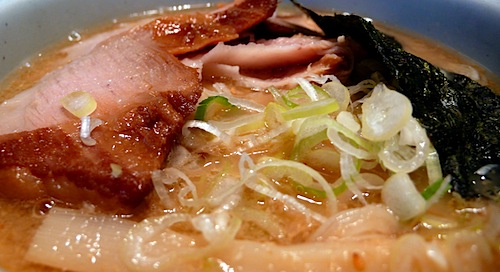
Izakaya
If kushi katsu was our favorite dish (after sushi, which is in a category all it’s own), then izakaya is our favorite type of meal. If ramen is the dish you eat at 3AM after a night of drinking sake, then izakaya is what you eat while you’re drinking said sake. Basically it’s pub food, but of course, the Japanese take it to a whole other level, with inventive dishes like pork stew drizzled with radish puree, or sesame tofu.
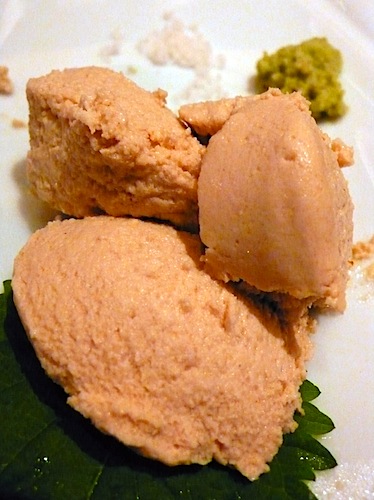
Homemade sesame tofu. Eaten at a fantastic restaurant that may or may not be called Ichi (website is in Japanese, so I can’t tell).
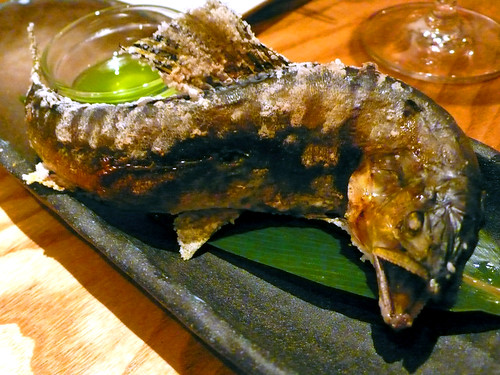
Deep-fried fish, impressively presented. Eaten at yet another amazing izakaya named Kinsai.
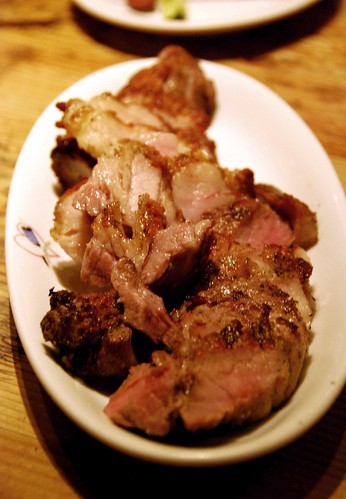
OK, this is just a plate of roasted pork, but we were so impressed with the size of this dish, I just had to include this picture. Eaten at Vinpicoeur.
The point is, it’s varied (so you get to taste a bunch of different stuff), it’s good, and you wash it all down with a cold beer, a shot of sake, or (Joy’s favorite drink) a glass of plum wine mixed with soda water (very refreshing!).
Shabu shabu
I grew up eating Taiwanese-style hot pot for holiday dinners, but I have to say, shabu shabu is different. First of all, the ingredients are cooked in stages: the meat is thrown in the pot first, in order to create a soup base for the vegetables, noodles, and tofu (in Chinese/Taiwanese hot pot, you just throw everything in all at the same time). Second, the meat used is super fatty wagyu beef, which creates a rich, delicious broth very quickly. And finally, instead of dipping your boiled goodies in a raw egg and soy sauce mix (like you do with Taiwanese hotpot), Japanese people grate a radish and add Ponzu sauce as their dipping mixture. I have to admit…Taiwanese hot pot will always hold a special place in my heart, but on taste alone, I think I might prefer the Japanese version (eek…don’t tell the Taiwanese food police!).
In a fit of complete decadence, we ate the above meal as a second dinner in Joy’s apartment while simultaneously watching Tampopo. Is it possible to get more gluttonous? I think not.
Japanese Pickles
Anyone who knows me knows that I love a good pickle. So believe me when I say this: the Japanese KNOW how to pickle. It’s not just that the veggies are perfectly crisp and salted…but there are other, unexpected flavors in the mix too, like a hint of shiso, or a touch of spice. A lovely surprise coming from the land of “we-only-know-how-to-use-dill.”
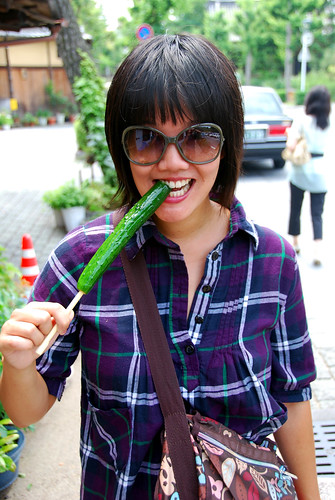
It’s a pickle. On a stick! Taken in Kyoto, Japan.
Japanese Desserts
Japan is famous for it’s Kyoto candies, but we hear they’re usually not actually very good (just pretty). In general, Asians prefer much less sugar in their desserts than Americans do (growing up, the biggest compliment my family could give to a cake was “it’s not too sweet!”). So, Japanese desserts were perfect for my tastebuds.
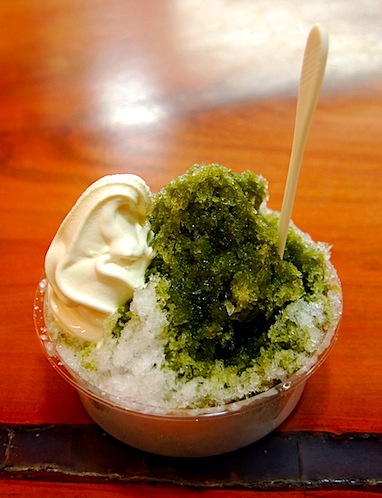
Green tea shaved ice.
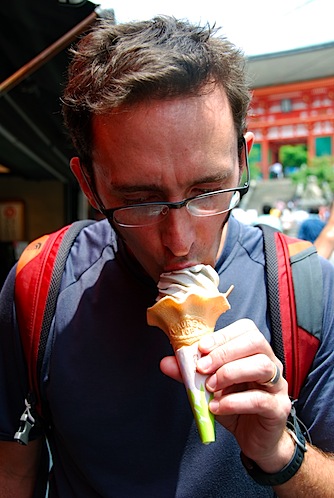
Jeremy eating black sesame ice cream.
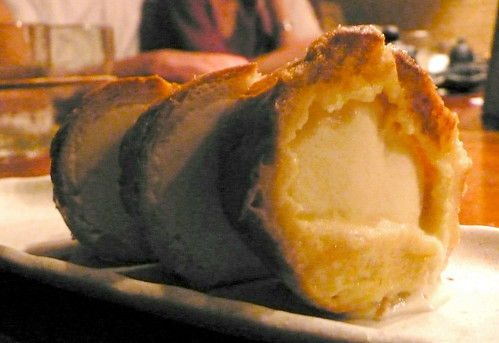
Apologies for the bad photo quality, but this thing was too good not to share. It’s called pan-ice, and it’s vanilla ice cream *inside* some slices of french bread. [Drool.] Eaten at Ichi.
The stuff we didn’t take pictures of
Kushiyaki: Grilled stuff on sticks. It’s good, and it’s inventive. Think enoki mushrooms wrapped in pork, spring onions wrapped in pancetta, grilled soy nuts, etc.
Okonomiyaki: The most un-Japanese dish we tried, mostly because it’s really messy. Okonomiyaki is basically an omelette or a pancake, filled with stuff, and then finished with a bunch of toppings, sauces (ahem, Worcestershire), and bonito flakes. We weren’t crazy about this dish, but I don’t think we gave it a fair shot—we only had it at a festival fair booth.
The weird stuff
OK, not everything in Japan is haute cuisine. This one made me scratch my head and think, really?!? Really, Japan?!? Like, for real?
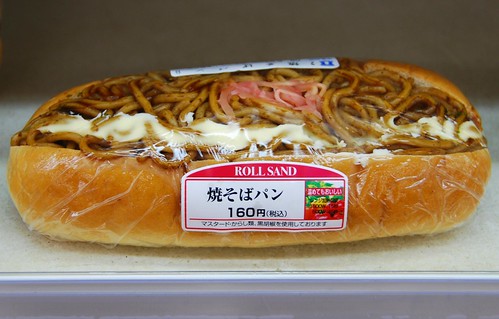
Noodle sandwich with mayo. Yum?
Maybe you can wash it down with some protein water? Or some shiso-flavored Pepsi?
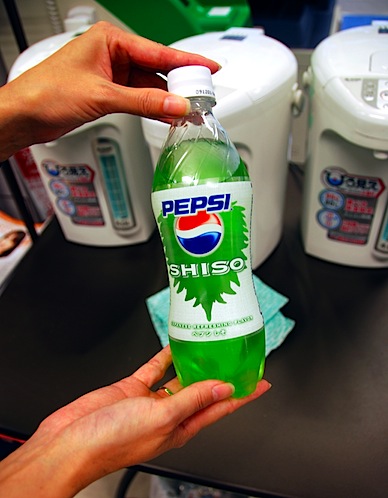
Traveling around-the-world on around-the-world tickets is a really affordable way to do an extended trip…but what you gain monetarily, you lose in convenience. The main restriction is that traveling overland counts as a leg, and since you’re only allowed 16 legs on your trip, it makes sense to try and fly out of the same city you flew into (for example, if we arrived in Japan via Tokyo, but we traveled via train to Osaka and wanted to leave from there, that trip would eat up one of our flights). This restriction only feels like a restriction when you aren’t too crazy about the city you flew into (ahem, Bangkok), but in the case of Tokyo, we were thrilled to get back to see Joy and Alex, eat more yummy food, and soak up some more Japanese culture before heading back to China.
Going back to Tokyo also gave us a chance to walk around the Imperial Palace Park, which we hadn’t done yet:
It also allowed us to squeeze in a few more tasty restaurants. Apparently, after our first stay in Tokyo (and after our hostess found out how much we like eating), Joy started researching reasonably-priced restaurants for us to visit on our return. We had a fabulous meal at a French restaurant that was no larger than a postage stamp but still managed to fit a WHOLE PIG inside their tiny little space:
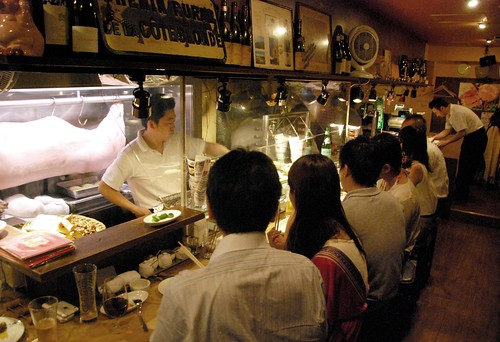
At Vinpicoeur “French Barbecue and Wine” Restaurant (+81 3-6212-1011) in the Ginza district of Tokyo. Yes, that’s a whole pig hanging in the back left of the restaurant.
AND (perhaps most importantly), Joy took us out for karaoke night! WITH COSTUMES!!! Now, if you know my family, you know that the karaoke gene runs deep with the Mengs. My brother goes to karaoke night every week (sometimes twice) in SF, my Dad has owned a laser disc karaoke machine since the early 90’s (with a gold microphone), and J and I had karaoke at our wedding. But if there is anything J and I (ok, *I*) love more than karaoke, it’s costumes. So costumes plus karaoke in one night was like discovering peanut butter and chocolate for the first time. In other words, it was DESTINY.
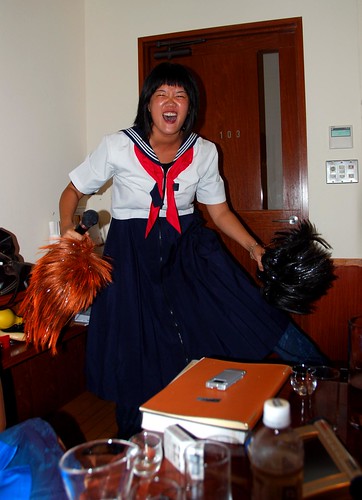
Singing “Hollaback Girl” by Gwen Stefani in a schoolgirl outfit. Why yes, I am using wigs as pom-poms.
Note to the budget-minded: karaoke in Tokyo is definitely not cheap. Those three hours in the karaoke room kinda blew the budget for the day, but it was worth it!
We love Tokyo and could actually imagine living here (if the apartment sizes doubled and the rents were cut by 50% OR if we won the lottery), and that is in no small part due to our amazing hosts. If you ever decide to quit your day jobs, Joy and Alex, you might want to consider teaching classes in hospitality, because you ROCK at it! Thanks for an incredibly tasty, boozy, and most of all, FUN time, Joy and Alex!
Here’s a convoluted statement for you: there are many reasons why Kyoto is amazing, and one of those reasons is simply because there are so many reasons! To clarify: the variety of things to do and environments to explore in this city is just astonishing. Urban life? Check. Temples? We covered that in the last post. Gardens? Yessiree. Markets? You betcha. Castles? Heck Yeah. Public parks? Yup. Good food? Well, of course, it’s Japan!
One of the (many) cool things we saw in Kyoto was Nijo-jo Castle. There really is something ancient about the place, and walking through the castle and grounds makes you feel like you’ve traveled back through time as an old Shogun.
Nijo-jo is famous for one thing: creaky floors. Seriously, they’ve actually engineered the floorboards to squeak so that bandits and perhaps a bitter feudal lord couldn’t sneak in to attack the Shogun housed within. It’s quite interesting to be walking along the palace interior in your socks (you have to take off your shoes whenever you enter any interior space in Japan), and having the ground sing underneath your feet. In fact, they’ve dubbed it “The Nightingale Floor,” and here’s how it works:
After experiencing Kyoto of the past, you can check out it’s present. Nishiki food market is a fun place to wile away an afternoon, checking out all the amazing foodstuffs that Japan has to offer. We ate tofu donuts (good!), saw hundreds of different types of Japanese pickles, and gawked at knives that cost more than some peoples’ monthly rent in San Francisco.
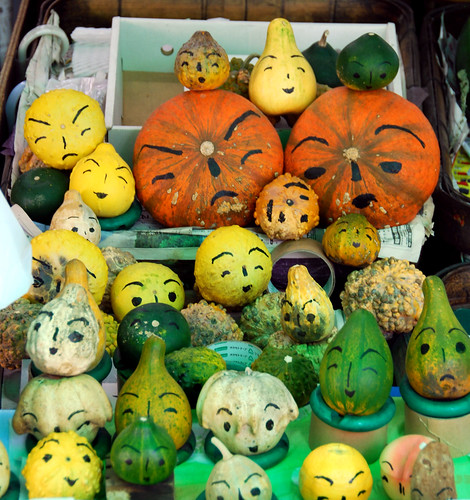
The many faces of squash. Taken in Kyoto’s Nishiki food market.
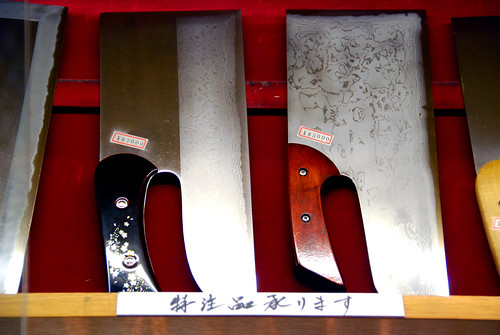
OK, this particular photo was taken in Tokyo, but we saw similar knives in Kyoto. These bad boys are specifically made to cut noodles. And at 84,000 yen a pop (about US$840), you’d have to cut a LOT of noodles to make this purchase worthwhile.
For an already green city, Kyoto also has some beautiful parks, where you can enjoy even more greenery. I can only imagine how jaw-droppingly beautiful Kyoto would be when the leaves are turning in the fall. Jeremy and I have already decided that we need to come back in the autumn (when all the Japanese maple leaves turn red), in the spring (when the cherry blossoms go off), and in the winter (when everything is covered in a blanket of white).
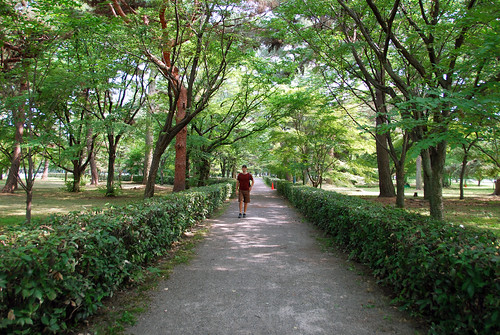
Strolling through the Imperial Palace Park.

There are ravens all over Japan. This one was perched at the top of a famous cherry tree in the middle of Maruyama Park—a tree that is apparently so beautiful when it blossoms that you have to view it from the hills in the back of the park because there are so many visitors mobbing the area. Unfortunately, the tree was looking kind of sad when we were there (in the summer).
Since we no longer had the benefit of a place to stay in Kyoto, we had to watch our budget a little more closely when it came to food. This turned out not to be too much of a problem, since there are some incredible (and affordable) ramen joints in Kyoto. Our favorite was a place called Santoka, which had a surprisingly hip and modern interior. But it wasn’t the decor that kept us coming back for more…it was the pork cheeks. Behold this bowl full of fatty, delicious beauty!!!

Even with the wealth of attractions in Kyoto, our favorite thing to do was just to walk. There is so much to see in the city’s narrow pedestrian alleyways…
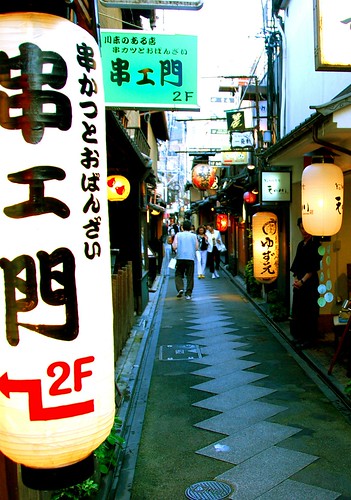
Pontocho Street, where Geisha often entertain at night in the exclusive clubs.
…or when you’re strolling by the river…
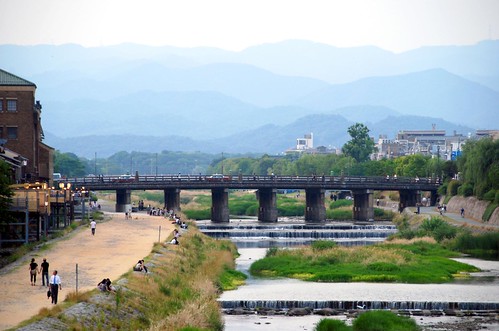
The Kamo River…look at those mountains in the background!
…or wandering in and out of temples.
In short, we love Kyoto. Maybe we’ll see you here next fall…or winter…or spring…or…?
When you think of Japan, you probably think of sushi; and when you think of sushi in Japan you probably think of Tokyo’s famous fish market. In addition to being the world’s largest wholesaler of fish, Tsukiji is a full-on tourist destination, one of the few that actually lives up to the hype.
Visiting Tsukiji can feel like a pilgrimage of sorts. For one, you have to wake up at the ungodly hour of 4:30AM if you want to catch the tuna auction, which starts around 5AM and ends by 7AM. Not only that, you have to be quick on your toes in those early morning hours! You see, Tsukiji is an actual, operating fish market, so there is a lot happening in those wee hours of the morn’…most notably the three-wheeled carts whizzing by you at breakneck speeds. In some cases, it feels like they are trying to hit you (and in some cases, I bet they are. I imagine a bunch of dazed and confused tourists wandering around your workplace is really frustrating when you are trying to do your job).
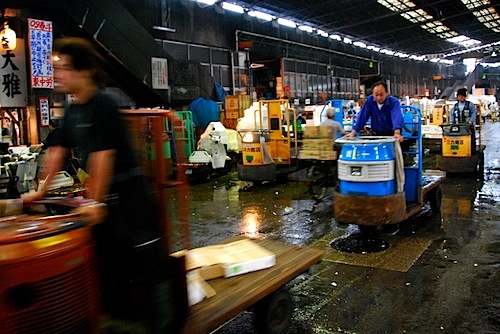
Three-wheeled carts whizzing around Tsukiji.
In fact, we sort of feel lucky that we’re able to see the fish market and tuna action at all, because rude tourists have almost shut the place down to visitors. Apparently, there were tourists handling the fish—kicking them like tires and even riding them as if they were bulls! I can’t even imagine how horrifying it would be to see a drunken (or not) lout sitting on top of a hundred thousand yen tuna…and particularly in Japan, a culture that revolves so completely around being reserved and respectful. Bad tourists! Bad, bad tourists!
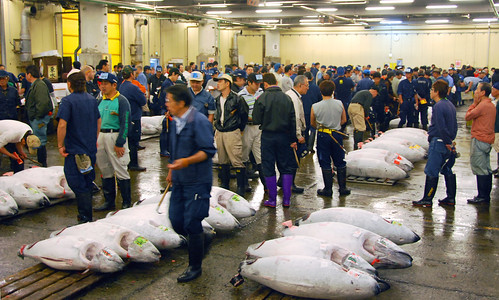
The tuna auction hall in action.
Actually, the one time we experience anything other than courtesy from Japanese people is at the fish market. We were quietly and unobtrusively watching a guy cut up his enormous tuna with increasingly larger and larger swords when another fishmonger came by, slapped both me and Jeremy on the arm, and yelled at us to “GO HOME!!! GO!!! GO HOME!!!” Though it was rude and shocking, I can’t say that I blame him…I would hate tourists too if I worked at Tsukiji.
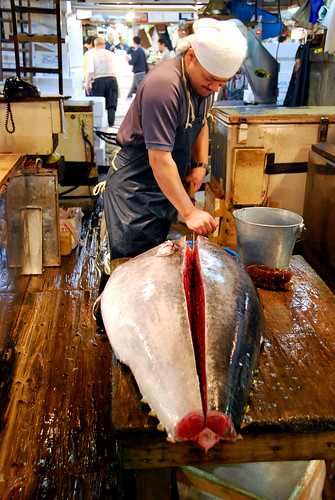
This is the guy we were watching when we got yelled at by the fishmonger. We were really entranced by the whole tuna filleting process! He washed down both the fish and the table in between each cut and had a special tool for each slice. It was clear that he took a lot of care in preparing this huge creature for eventual consumption.
Visitors to the tuna auction are now confined to a narrow band of space within the auction hall no wider than a sidewalk (apparently you used to be able to walk amongst the fish and the buyers). But even from afar, it was totally fascinating and fun to watch the auction. Each auctioneer had his own unique, captivating style…see for yourselves:
After the tuna auction closed, we wandered around the absolutely enormous market (seriously, we visited the Sydney Fish Market back in January and Tokyo’s version is easily 25 times the size of that market) and watched people carving tuna (both frozen and fresh).
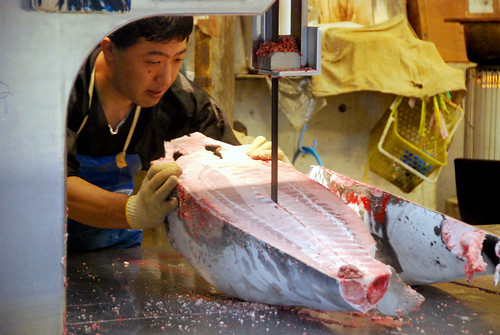
Cutting frozen tuna with a bandsaw.
We also saw a huge variety of sea creatures, both recognizable and not.
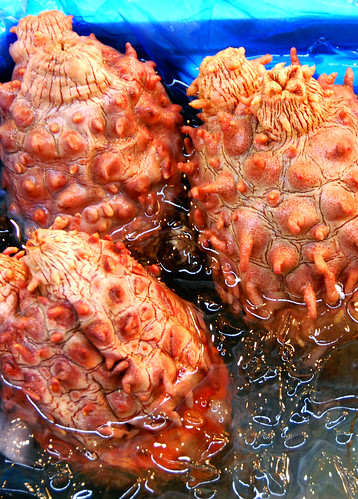
Unidentified sea creature. Anyone know what this is?
Like most other visitors, we completed our visit with a sushi breakfast—another Tsukiji rite of passage, no matter that you’re chowing down on raw fish at 8 o’ clock in the morning. If we had to do it over again, we’d probably eat our sushi right outside of the market, where the prices are easily half of what they are inside the market stalls.
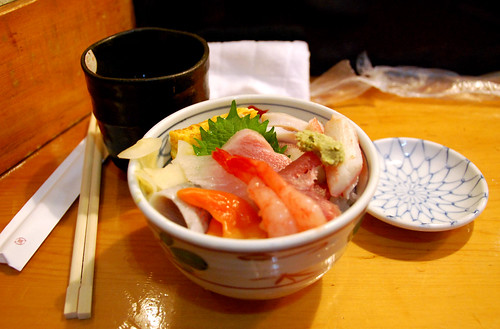
Our Tsukiji chirashi breakfast.
And, with our bellies full of raw, delicious fish, we went back to Joy’s apartment to take a nap. ![]()
See all of our photos from Tsukiji Fish Market on our Flickr
One thing that has really delighted us on our travels is the fact that our assumptions about a place have very often been completely wrong (particularly in Asia). We thought Taipei would be dirty and crowded. Wrong—Taipei is a clean, modern city that holds it’s 2 million residents comfortably. We thought China’s streets would still be swarmed with bicycles and people wearing Mao jackets. Wrong again—the rising middle class here means there are more cars than bikes, and most people have discarded the drab Communist-era rags for any and every patterned and blinged-out piece of clothing they could get their hands on. And we thought Tokyo would be a huge, crazy metropolis. Take a wild guess if we were right or wrong on that one.
To be fair, I guess in some ways, Tokyo is sort of crazy. I mean, there are a lot of people, especially around Shibuya and Harajuku.
The difference is that Tokyo doesn’t feel chaotic at all. Perhaps this lack of chaos owes itself to the fact that the Japan is such a rules-based society, and the rules here say that citizens should be orderly and polite, treat others with kindness and the utmost respect, and speak in a low tone of voice. In fact, we can’t get over how quiet it is here! No honking horns, no blaring music, no clanking of wheels, no sounds of construction. Granted, our aural radars might be off a bit after China, where someone turned the volume up to 11, and then broke the knob off.
This is one of the most delightful things about Tokyo—how peaceful it is for a big, cosmopolitan city. And, similar to our reaction to Taiwan after SE Asia—it’s just so civilized here! I mean, the taxi drivers wear full suits, hats, and little white gloves! There are little lace covers on the seats, some taxi drivers give you free lollipops, and the doors even open and close automatically! Now that’s classy!
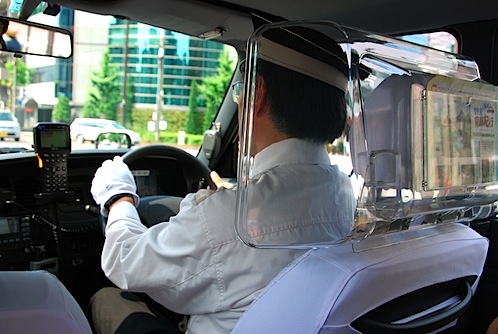
From the back seat of a Japanese taxi.
But of course, we don’t like Tokyo just because it’s quiet (that was just the icing on the cake). Make no mistake: Tokyo is a beautiful, vibrant city…
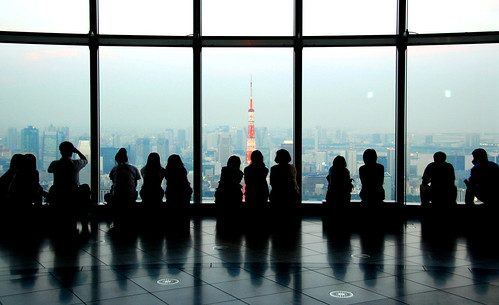
View of Tokyo Tower from the top of the Mori Building.
…full of little quirks and oddities…
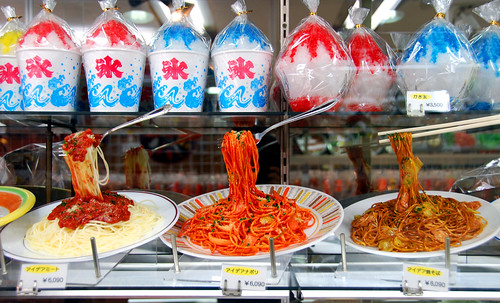
Kappabashi dori in Tokyo, a restaurant supply street, where you can buy all manner of red paper lanterns, chopstick holders, and yes, plastic food.
A pachinko parlor in Tokyo. Pachinko is a strange gambling game that looks like a pinball machine; the player shoots a ball straight up into the machine and depending on where it lands, you can win more balls, which you can trade for tokens, which you can then trade for cash at some other location (gambling is illegal in Japan, so this is how they circumvent the laws).
…beautiful gardens…
Women walking through the gardens near Meiji jingu.
…and funky people, who take care in their appearance, whatever that style happens to be.

Kitty cat girl in the Harajuku area.
It is a city that delights in technology and innovation…one look at their toilets, and you know that they are light years ahead of us in the States. Toilets in Japan come with some serious functionality: automatic open opening and closing of the lid. Bidets with varying levels of pressure. Fans and heated dryers (for use after the bidet). Automatic flushing. And (our favorite): some toilets even play music, or a “flushing water” sound, so that you can do your business without worrying that the person in the stall over will be disturbed by any, um, noises.
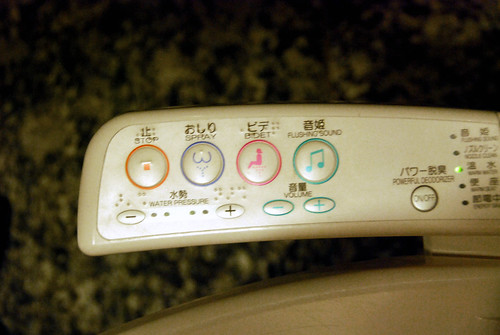
Typical control panel on a Japanese toilet.
Despite this fascination with all things new and novel, Tokyo still manages to preserve it’s traditional culture. We saw women getting on the high-speed bullet train in their kimono and dessert chefs checking their cell phones in between hand-rolling Japanese-style candies. And it seems, to the outsider, anyway, that this balance between the new and the old is preserved without tension, and without feeling contrived. It is simply Tokyo doing what it does best—embracing it’s Japanese-ness with dignity and delight, and welcoming you along for the ride.
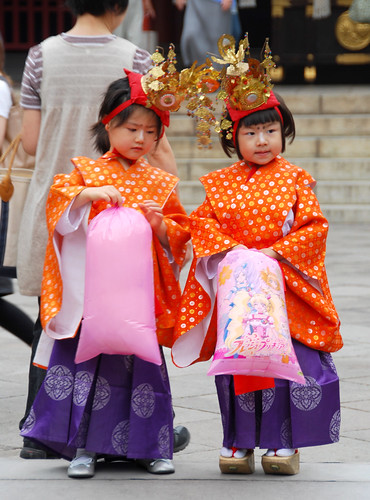
Little girls in traditional kimono and headdress at a local temple, holding on tight to their bags of cotton candy.
We step off the plane in Tokyo, and we discover something extraordinary: we have x-ray vision!
At least, that’s what it felt like, seeing the world without smog. It was like someone flipped the switch on our retinas from regular broadcast to HDTV. As we get closer to the city, we discover another super sense: our hearing has turned supersonic! Tokyo is a huge, sprawling metropolis, but somehow, the city is dead quiet. Where is the constant honking? The people yelling at each other on the streets? The tour groups following a megaphone-wielding tour guide?
Even at the airport, Jeremy and I couldn’t stop talking about how different Japan is from China. There were two ladies whose only discernible job was to bow at you as you got on the escalator and say “Irashaimase!” (”Welcome!”). The ticket-taker bowed at our bus as it left the curbside. And the smokers! They had to walk outside and go into what can only be described as a Smoking Box (it was like observing animals at the zoo…Oooh! Look! It’s the Commonicus Smokeritus!), so that their exhalations wouldn’t bother us non-smokers out on the sidewalk. How is it that Japan and China are even on the same planet, much less the same continent?!?

The Smoking Box at the airport. Smokers have to leave the terminal and enter this box in order to light up, so that their exhalations don’t bother other people out on the sidewalk.
Japan can strike fear into the heart of any budget traveler, but as soon as we land, we can see that we’re going to want to extend our stay, even without any solid plans for our trip here. It is just so freakin’ peaceful in this country (even in the big city), and after a month of Chinese chaos, we’re ready to decompress, watch the world through HD, and listen to the glorious sound of (relative) silence.
But, good lord is it expensive! Luckily, we’ve hooked up with an old college friend of Jeremy’s named Joy, who is a Japanese-American expat working in Tokyo, and she’s offered to help us plan our itinerary while putting us up in the huge, gorgeous apartment she shares with her Aussie boyfriend Alex in the Akasaka district of Tokyo. This is a real treat—I was sure that, given our budget, we were going to have to rent out a spot in Kramer’s chest of drawers.
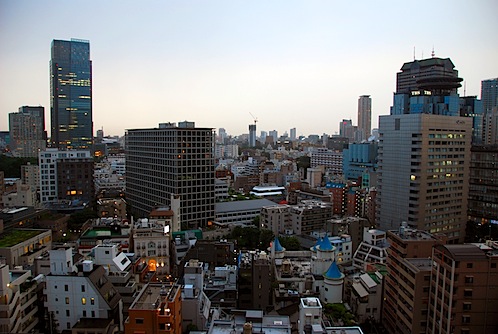
The view from Joy and Alex’s apartment.
The last time Jeremy bumped into Joy was in SF, and the occasion was actually on our first date—over 6 years ago! Through a crazy Flickr coincidence involving my wedding dress and Joy’s friend Jean, we’ve gotten back in touch with her. Joy is an AMAZING hostess…not only does she love food like we do, but she was mindful of our budget, and she swiftly went to work taking us to all these incredible midrange restaurants around Tokyo. Even better, because we’re saving so much on hotels by staying with Joy and Alex, we actually have some leeway in our budget to sample some of this famously delicious Japanese cuisine.
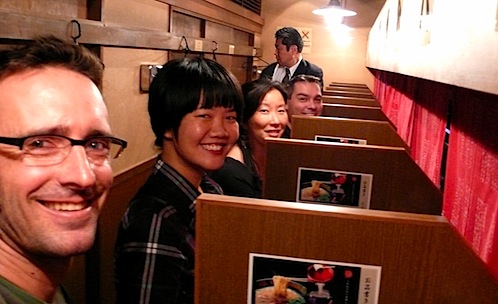
Out with Joy and Alex at our first Japanese ramen experience. You purchase tickets for your ramen via a vending machine, and you personalize your bowl of noodles by filling out a questionnaire, indicating how fatty you like your broth to be, how many green onions you want, if you want pepper flakes, etc. I felt like we were taking a ramen test! A server lifts up the red curtain in your stall, slides your ramen towards you, and you chow down in your own personal noodle-wrestling booth. No cheating allowed!
OK, but first: did you know that there are no street names in Tokyo? No, seriously. For real. Japan’s capital city—a city of over 12 million people—has no street names. Why did we not know this?!? Joy kept explaining how to get to a destination with instructions like, “turn left at the love hotel that looks like a castle,” “it’s a few shops past the mermaid bar,” or, even better, making us go out on her balcony and explaining the route with a bird’s eye view of the city. We were getting increasingly frustrated and couldn’t understand why she wouldn’t just say “turn left at so-and-so street.” Until we realized that there is no such thing as “so-and-so street.”
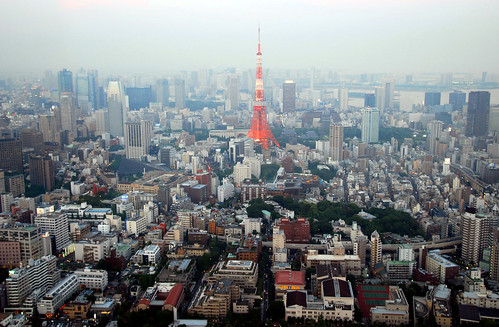
View of Tokyo Tower from the Mori Building. At least that’s easy to find—just look for the big red pointy thing.
Further, buildings are numbered in a totally random fashion—by the date they were built. So finding a restaurant or bar is usually a bit of an adventure—typically, you just get to the general area, and then you have to ask around to see if anyone can point you to your final destination. Then once you finally find your destination, the first thing you do is a grab a card (in case you ever want to come back—all business cards in Tokyo are printed with a map describing the establishment’s location), and look around you, trying to sear the surroundings into your brain so you have some way of finding the place again (Is it next to a strange looking sign or statue? Is there a unique building across the street?). Jeremy and I found this process totally fascinating…I mean, what does it say about a culture when everything—including the location of your apartment—relies on context?
Making things even more difficult is the fact that very few people speak English here. Luckily, we are usually out with Joy (who speaks Japanese)…and when we’re not out with Joy, we are out with Joy’s instructions, which explain very clearly how to get from point A to point B. This makes the experience on finding stuff in Tokyo a lot less stressful than it could be. I have to admit, I don’t miss being the only one able to speak the local language. ![]()
Despite the difficulties (which actually just make things more endearing), Jeremy and I quickly become enamored with this beautiful culture. In fact, we see a lot of similarities between Japan and Taiwan (which also hold a special place in our hearts)—particularly the fact that everyone is exceedingly polite and just plain helpful. In some ways (this is going to make my Dad have a heart attack), it almost seems like Taiwan would have an easier time (culturally, anyway) merging with Japan than it would with China.
But it’s the little things that make us really fall hard for this country: the fact that most of the ice cubes in Tokyo are hand-chiseled (really, they’re gorgeous). The elaborate toilets. The beautiful manhole covers. The amazingly fashionable people (women in Tokyo can give you a serious ugly duckling complex, especially when you’re wearing Keens). And yes, the sweet, sweet silence. Of course, it doesn’t hurt that the food is incredible.
Yes, I think we’re going to like it here. ![]()
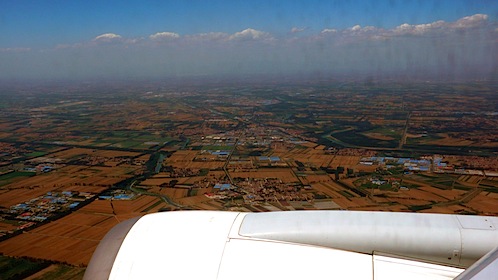
View as we fly into Beijing from Tokyo. Apologies for the dirty window!
Hiya! Just a quick note to let y’alls know that we’ve updated our route map! Our original plan was to fly to Jordan after China, but we just discovered that it’s going to be “capital H” Hot there right now. So we’ve added London as a destination, mostly because we have friends there (and we’ve had such an amazing time visiting places where we know peeps!), but also to kill sometime while this planet cools down a bit (at least in the northern hemisphere).
Note that for all future destinations on our map, we’ve only added our flight points…for instance, when we’re in London, we will actually be visiting Ireland and…some other mystery country (possibly Sweden because we have family there, but we are open to other suggestions if you’ve got ‘em!), even though our map only shows that we will be in London for 3 weeks. Also, we show Madrid as a destination, but we won’t be staying there long (if at all). Due to restrictions with our around-the-world tickets, we are just using Madrid as a jumping-off point to go to northern Africa (Morocco, possibly Tunisia). Our plans have been rather fluid as of late, and it feels right to make decisions as we go, so we just don’t want to jump the gun and say we are going to be somewhere and then disappoint you later. ![]()
As a general guideline, here is our future travel schedule:
- July 16 to August 10: London, Ireland, mystery country (possibly Sweden or Denmark)
- August 10 to September 7: Turkey
- September 7 to September 16: Jordan
- September 16 to October 2: Egypt
- October 2 to October 16: Morocco or Tunisia (via Madrid)
- October 16 to October 30: Peru
- October 30 to November 29: Argentina
- November 29 to December 12: Chile
- December 13, 2009: Home to San Francisco!
Also, we’ve added all our stops in Asia to the map so you can see all the places we’ve been so far! Enjoy!
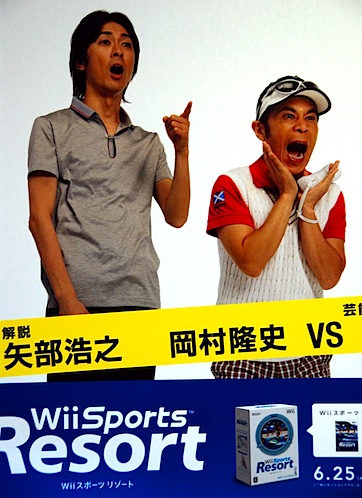
This photo has absolutely nothing to do with any of this, it’s just a really funny ad we saw in Japan. Totally made my day…hopefully it will bring a smile to your face too!
Here is a collection of both general travel and country-specific websites we’ve used to book hotels, figure out logistics, or just gather information.
GENERAL TRAVEL
Lonely Planet
Lonely Planet guidebooks are indispensible in Southeast Asia, but we’ve found them somewhat lacking in the Middle East (i.e. Turkey and Egypt). Their Thorntree Forum can be very helpful when you’re off the beaten path and you need some information that the books are lacking.
Wikitravel
Lonely Planet has great info, but their books are only updated once every two years, which means it is often out of date by the time it’s in your hands (especially in places like SE Asia, where prices can change from week to week). Also, many hotels and restaurants can suffer from what we call “Lonely Planet Syndrome,” meaning they jack up their rates or the quality decreases once they’re mentioned in the backpacker’s bible. Wikitravel usually has more current info and can be a great source for hostel and hotel recommendations.
TripAdvisor
Great resource for hotel information in developed countries, esp. Europe. To find information on hostels, click on the “Specialty Lodging” tab at the top of a specific city’s hotels page.
Couchsurfing.org
We haven’t used this service yet, but we’ve met other travelers who have had great experiences with it, especially in larger cities. We cant wait to use it and report back!
US State Department Country-Specific Travel Requirements
If you’ve got a US passport, click on this page to find out visa and entry requirements for any country in the world.
BootsNAll
A good place to start if you are researching an around-the-world trip.
OneWorld
This is the airline alliance we went with for our around-the-world tickets. For a great rundown of all the different alliance options, check out the round the world flights wiki page.
AirAsia
A budget airline that flies the all the major cities in Asia and Australia.
ARGENTINA
Saltshaker.net
A Buenos Aires-centric food blog. DROOL.
AUSTRALIA
Jetstar
The “Southwest Airlines” (i.e., budget airline) of Australia. Note: if you are flying into Melbourne, don’t make the same mistake we did and fly into Avalon. It’s out in the boonies.
Wotif.com
For last minute hotel deals. Technically, they cover hotels around the world, but it’s really most developed in Australia.
SydneyLinks
We found our apartment in Sydney via this website. The apartment was in a great location (Potts Point), the price was reasonable (about US$125 per night over the NYE holiday, when apartment rental prices can go through the roof), and the staff was very professional.
The Nunnery
A little steep for a private room, but otherwise a GREAT little backpacker spot in an excellent location in Melbourne.
Deep Sea Divers Den
This is the liveaboard we did in Cairns to dive the Great Barrier Reef. Read about our experience here.
Cairns Unlimited
We rented a camera from Cairns Unlimited for 3 days, and it cost about 75AUD, approx. US$58 (which is a good deal considering rental on the boat is about 25AUD per dive or something like that?). They were great! Not only did they deliver the camera to our hostel, but they picked it up after we got off the boat, and delivered a DVD with all our images the next day. Now that’s what we call professional! Check out the photos from our dive trip here.
BOLIVIA
Travel-Bolivia.com
An excellent resource on the major sites in Bolivia, plus transport and accommodation info.
CHINA
ctrip.com
A great online resource (in English!) for hotel bookings and flight arrangements. We typically pay the same amount for a hotel using this website as we would if we stayed in hostels. We’ve also found great flight deals on this website—we flew from Wuhan to Shanghai for 200RMB each (about US$30)…cheaper than taking the train! And best of all, they came to the rescue when a hotel in Beijing was trying to upsell us to a pricier room, saying that the budget room we booked was not available. A great resource in a country that’s not exactly known for it’s service skills.
ChinaTravelGuide.com Train Schedule
An online database of China’s train schedules. Just type in two cities, and all routes between point A and point B will be listed! Super handy!
JAPAN
JAPANiCAN
A great website for online hotel bookings at discounted rates. We wanted to extend our stay at a hotel in Kyoto, and when we asked at the front desk, the price was 2000 yen (about US$20) more expensive than the online price! So we booked the extra night online and spent our extra yen on a bowl of ramen.
Japan Rail
You simply *must* buy this rail pass if you are thinking traveling around Japan on a budget. A 7-day pass is almost the same price as a round-trip ticket from Tokyo to Kyoto, so if you have any other destinations in mind, it’s worth it!
JORDAN
Jordan Jubilee
Incredible online resource on Jordan, by a Western woman who now lives part of the year in Wadi Musa. So good we didn’t need any other guide (ex. Lonely Planet) for the country.
NEW ZEALAND
Kiwimaps
We picked up this road atlas in New Zealand, available at any supermarket or drug store. It was awesome! Campsites, gas stations, and activities are clearly marked on the map with icons, so you know if the town you’re approaching has a holiday park, a surf break, or a glacier. We didn’t have a Lonely Planet or other guide in New Zealand…just this trusty map and some recommendations from a friend we met on the plane. ![]()
SOUTHEAST ASIA
Travelfish
Excellent and current guide to transport and accommodation in a region where guesthouses can go out of business from one week to the next and border crossings can close in a heartbeat. Definitely a must for anyone thinking about backpacking through this region.
TAIWAN
Forumosa
Everything you could ever want to know about Taiwan—from where to find used clothing to the best hiking trails. And it’s in English!
Taipei Day Trips I & II by Richard Saunders
A wonderful guide to hiking and walking trails all within day-trip distance of Taiwan’s capital. We did at least 5 of the trips outlined in Taipei Day Trips I while we were in Taipei.
TURKEY
Turkey Travel Planner by Tom Brosnahan
Great info about Turkey. We found the bus company section and the info on travel during Ramazan particularly helpful.

